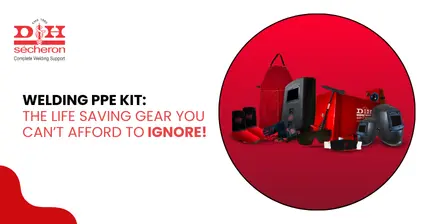Advantages of SAW Welding: Efficiency, Quality, and Cost Savings
Introduction
Submerged Arc Welding (SAW) is a set process of automatic welding in which a continuous feed of filler/electrode, melted by an electric arc between the electrode/filler and the work, is used. In this blog, we will explore the benefits of the SAW welding process, mention the advantages, and explore our offerings.
Understanding SAW Welding
SAW welding is the welding process of high productivity, normally automated/mechanized. It is involved in forming an electric arc between the workpiece and the continuously fed electrode. A blanket of powdered flux layer 2 covers and protects the electric arc. This process does not require the use of an additional shielding component, like inert gas.
SMAW Electrodes and Rods
Essentially, Shielded Metal Arc Welding (SMAW) is referred to as "stick" welding, as the electrodes utilized during the welding process have such kind of terminological nomenclature. In the center of the SMAW electrode is a bare metal rod chosen to closely match the base metals in the weld joint. SMAW electrodes come in a variety of metallurgy and sizes, and each one has its own specific purpose.
Welding Wire
In Gas Metal Arc Welding (GMAW), all the deposit required for a weld comes from a spool of metal wire. The wire would reel off the wire feeder of the welding machine. The wire feeds each time the trigger of the welding gun is pulled. When the wire comes into contact with an electrically grounded workpiece surface, arc initiation is produced, and at the same time, the process of melting the base metal commences.
Advantages of SAW Welding
SAW welding offers several advantages:
High Deposition Rates: SAW welding has higher deposition rates than other welding processes.
Deep Weld Penetration: It offers deep weld penetration.
High-Speed Welding: SAW is faster than traditional welding processes.
Electrical Efficiency: It offers high electrical efficiency.
Minimal Welding Fume or Arc Light Emission: SAW welding emits minimal welding fume or arc light.
Conclusion
The large-scale acceptance of SAW welding in the industry is due to its efficiency, quality, and cost reductions in welding. We at D&H Sécheron offer an entire range of world-class quality SAW welding products, having thickness, specifications, grades, and sizes as needed by diverse customer needs. Our products are engineered to give perfect results and help raise the efficiency level.
11 May 2025 | Welding
An In-Depth Exploration of Low-Alloy Steel: Your Comprehensive Guide
11 May 2025 | Welding
Nagpur - Bori - Tuljapur Road MSH-3 in Yavatmal District (Maharashtra)
11 May 2025 | Welding
Guidelines to Understand Gas Welding: Applications, Advantages & Disadvantages
11 May 2025 | Welding
3 Tips for Finding the Best Mild Steel Electrode for Your Application
11 May 2025 | Welding
How to Select the Right Welding Filler Wires for Stainless Steel Welding?
11 May 2025 | Welding
Building the Narendra Modi Stadium with Norma V and Autotherme-1 Electrodes
11 May 2025 | Welding
Low Alloy Steel Welding in a (PEB) Pre Engineered Building Structure
11 May 2025 | Welding
Welding Rods: Different Types and Tips for Properly Storing and Handling
11 May 2025 | Welding
Tips for Flawless Welds with Stainless Steel Electrodes: Pros and Cons
11 May 2025 | Welding
Exploring Applications and Benefits of Stainless Steel Welding Electrodes
11 May 2025 | Welding
Welding Basics: Joining Metals with Heat and Pressure - A Beginners Guide
11 May 2025 | Welding
Distinguishing Low-Alloy Steel from High-Alloy Steel: Understanding the Variations
11 May 2025 | Welding
Hard Facing Wire - Understanding the Process and Achieving Optimal Result
11 May 2025 | Welding
Exploring the Advantages of Stainless Steel Electrodes in Welding Applications
11 May 2025 | Welding
Weathering Steel vs. Traditional Steel: A Comparative Analysis of Performance
11 May 2025 | Welding
Choosing the Right Welding Rod: Why 6013 Electrodes Might Be Your Ideal Option
11 May 2025 | Welding
Why 7018 Electrodes Are Preferred for High-Strength Welds in Pipeline Construction
11 May 2025 | Welding
Filler Wire vs. Stainless Steel Filler Wire: Understanding the Key Differences
11 May 2025 | Welding
Exploring the Impact of Filler Material on Welding Quality and Durability
11 May 2025 | Welding
Choosing the Right Cast Iron Electrode for Different Welding Projects
11 May 2025 | Welding
Top Advantages of Cast Iron Electrodes for Industrial Welding Applications
11 May 2025 | Welding
Key Benefits and Challenges of Using TIG Welding in Industrial Projects
11 May 2025 | Welding
5 Reasons Why 7018 Electrode is the Gold Standard for Welding Professionals
11 May 2025 | Welding
Top 5 Advantages of Flux Cored Arc Welding for Heavy-Duty Applications.png)
11 May 2025 | Welding
Lotherme-601: A Game-Changer for Restoring Shoulder Pins in Heavy Machinery
11 May 2025 | Welding
How D&H Sécheron Helped Repair a Rotary Kiln’s Cooler Section with LoTherme 352
11 May 2025 | Welding
Piston Repair for Mining Industry: Cost-Effective Solutions with LoTherme 468.webp)






.jpg)








































.jpg)
.jpg)

.jpg)

.jpg)





.jpg)
.jpg)
.jpg)



.webp)
.jpg)
.jpg)
.webp)
.jpg)





















.png)



.webp)

.webp)
.webp)



